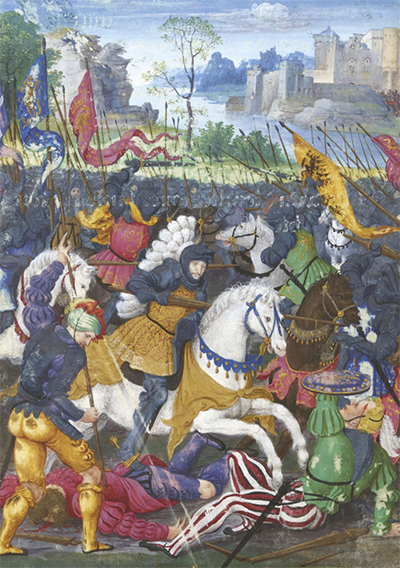The battle of Marignano: 13 and 14 September 1515
On his accession to the throne in January 1515, Francis I asserted his claim to the Duchy of Milan. Having secured the neutrality of the Holy Roman Emperor and the King of England and, more importantly, the support of Venice and the backing of Genoa and Savoy, Francis I marched towards Italy at the head of his army, leaving his mother, Louise of Savoy, as queen regent.
The French army’s strength lay in its artillery: 2,500 gunners operating 60 heavy guns and 200 lighter weapons. The King of France also recruited 22,000 German mercenaries, including 17,000 Landskenechts.
The soldiers assembled in Lyon in the summer of 1515, under the command of the Constable of Bourbon, infantry commander Pedro Navarro and the renowned knight Sir Bayard.
In response, 35,000 Swiss infantrymen marched on Suse and Pignerol, which they occupied, blocking the French army’s usual routes across the Alps at the Mont Cenis and Montgenèvre passes. In August 1515, the main body of the French army left Lyon for Grenoble and Mont-Dauphin, where the army split into several groups. The larger section, commanded by Pedro Navarro, cut southwards and crossed the passes at Var and Larche for the first time, carving out a route using explosives.
While the Swiss, caught off-guard by this unexpected manoeuvre, doubled back to the east, Bayard and his men met up with the main body of the army in Turin, where Francis I was received by his cousin Charles III of Savoy.
From there, the French reached Novara and Pavia and went on to set up camp in Marignano near Milan. Facing them was Maximilian Sforza, Duke of Milan, ally of Spain, Pope Leo X and the formidable Swiss, who were thought to be invincible.
Rather than launching an assault against the duke, whom he knew to be deadly, King Francis negotiated with the Swiss who agreed to retreat for a large sum of money. 12,000 mercenaries abandoned Milan. Fearing total defection, on 13 September Cardinal Matthias Schiner, acting for Maximilian I of Habsburg, led a small troop towards the French camp and spread the rumour that the French had launched their attack. 22,000 Swiss soldiers then marched on them and the battle began. The ensuing assaults were heavy and at midnight the fighting was halted, to be resumed at dawn the next day.
In the morning, the French army assembled around its artillery. The Swiss attacked first, but they were uncoordinated and failed to push back the cavalry charges. In the heat of the battle, around 11 o’clock the Venetian reinforcements arrived on the battlefield and Francis I regained the upper hand.
Seeing these powerful reinforcements, the Swiss captains ordered the retreat. The next day, the French entered Milan, now deserted by the Swiss, and Maximilian Sforza was taken prisoner and exiled to France.
It was the longest and deadliest battle that France had ever fought.

















